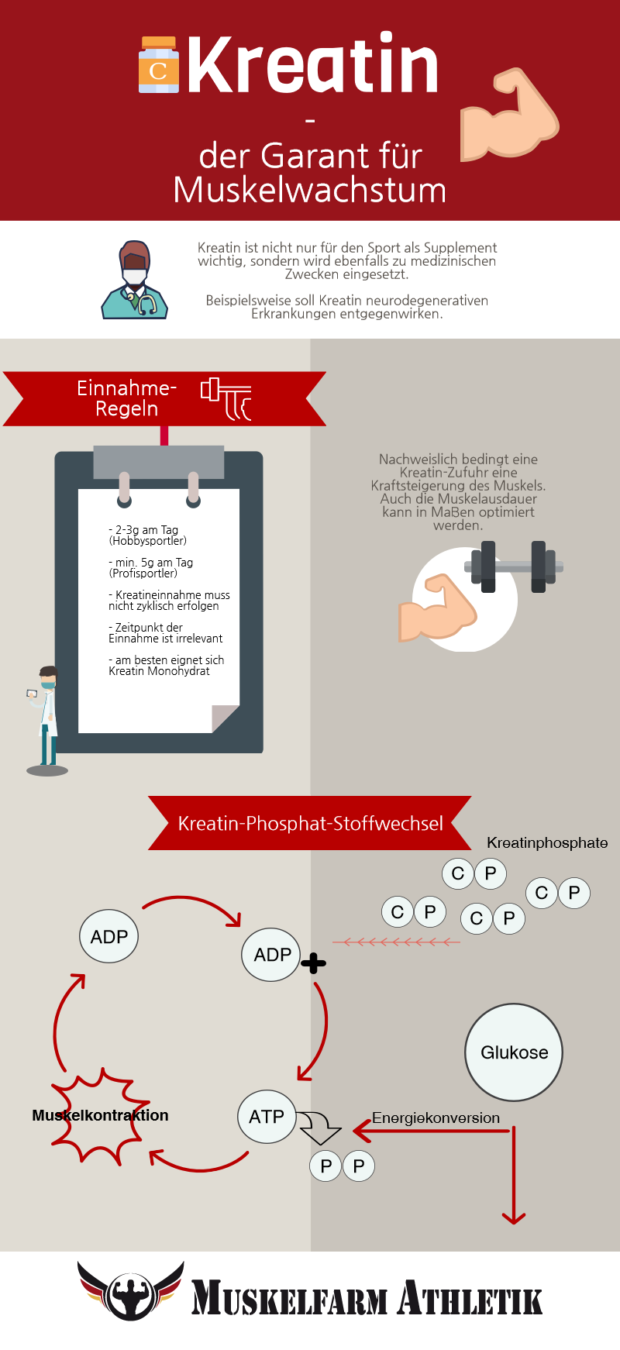More muscle mass through creatine? - Everything you need to know about the creatine supplement
It comes again every year, the time when even the most unsporty person suddenly rediscovered his urge to get his dusty fitness card out of the closet - it's summer time and everyone wants to look good. In the meantime, bodybuilders and strength athletes struggle in the fitness halls and strive for their best form for the beach season. The legal supplement creatine in particular promises strength and muscle growth. But how does it work exactly and what effect is achieved by this supplement?

Before, during or after exercise - when do you take creatine?
(Image Source: Rocksweeper - 520637818 / Shutterstock.com)
Whenever it comes to supplements, the accusation that one would “stuff” is not far. To clear up a fundamental mistake: Creatine is not illegal and can be found in practically every reasonably good fitness store - and that's why naturally also with us.
Especially since you should also keep in mind that basically everyone consumes creatine on a daily basis unless they happen to be vegan. Because in many types of meat there is at least a small amount of creatine, which is nothing more than an organic acid made up of the three amino acids
- Arginine
- L-Glycin
- L-Methionin
composed. Quite apart from that, every person has a reserve of creatine in their skeletal muscles. This is also absolutely necessary, because otherwise it would not be possible to produce so-called adenosine triphosphate, which is particularly important in anaerobic exercise such as weight training.
And this fact also explains why pure creatine, also called Creatine monohydrate marketed, is so popular with amateur and top athletes. Creatine is considered to increase performance, so to a certain extent a legal and natural doping agent. But how does this work and how should athletes consume it?
This is the effect of a dietary supplement with creatine
First of all: No, by taking creatine, the muscle does not grow by itself as if by magic. That would be nice, but it remains a utopia. However, this does not change the fact that creatine can be used to create the perfect physiological environment, so that maximum muscle hypertrophy is stimulated.
There are reasons for this. The purpose of a creatine supplement is to increase muscle strength and - even if only in moderation - to optimize strength endurance. In practice, this means that higher weights can be moved over more repetitions or even sets during training. Thus, the net weight that you move increases. In the end, this means greater muscle stimulation and thus improved muscle growth.
Caution, before you decide on creatine, you should first deal with your training. Creatine is not an all-purpose solution.
But this can also be read on other fitness blogs. We would like to go into a little more detail and explain the effects of creatine in detail. Because this is the basis for understanding how creatine should best be used as a supplement to proper nutrition.
Sense and purpose:
- The purpose of taking creatine as a supplement is to increase the concentration of creatine in muscle cells.
- This allows the body to use more phosphate molecules for ATP synthesis, which optimizes muscle and strength performance.
Procedure:
- The substance creatine is part of the so-called creatine-phosphate cycle.
- In this system a distinction must be made between creatine and creatine phosphate.
- The purpose of the phosphate group is to regenerate other molecules that lack a phosphate.
- This applies, for example, to ATP (adenosine triphosphate), where “tri” stands for “three”. ATP is obtained from ADP (adenosine diphosphate), here "di" stands for "two". Adenosine with two phosphate molecules becomes an adenosine with three phosphate molecules within the creatine-phosphate cycle.
- ATP can be used as a Fuel the cell to be viewed as. Muscle work is not possible without ATP.
Episode:
- If the ATP is used up and the body is unable to produce enough ATP within a short period of time, this leads to muscle failure.
- If the ATP concentration in the body is increased through supplementation, more phosphate groups can be made available for the synthesis of ATP, which improves muscle or strength performance and also muscle endurance.
How should creatine be taken? Cyclical, as a cure?
If you look around the market, you will quickly see that there are many different dosage forms and names for creatine. It should be said here that simple creatine monohydrate together with a little glucose is completely sufficient to achieve the desired effect.
Many suppliers have already added a “transport substance” to pure creatine, i.e. the monohydrate, and therefore call their product, for example, creatine “complex”. Basically, the same thing is contained in all products, there are basically no different "forms of creatine", but they mostly consist of different compounds that are supposed to improve water solubility, for example. However, it has not yet been proven whether this will achieve a better effect in the long term.
In addition, the rumor should be cleared up here that creatine must be taken as a cure or cyclically. Many portals recommend that you complete a cure with a one-week “loading phase” and three-week “holding phase” in order to then completely forego creatine intake for one to two weeks. At least from a physiological point of view, this makes little sense.
On the one hand, the body usually needs significantly longer than one to two weeks to extract creatine from the body, and on the other hand, there is no known creatine sensitivity, and no tolerance is developed that could justify periodization. So why stop the creatine intake or why periodize it?
Here are our tips and hints for creatine intake:
- Hobby athletes should consume between 2-3 grams of creatine per day.
- Competitive athletes or hobby athletes with a particularly high training volume (6-7 days of training per week) should consume at least 5 grams of creatine per day.
- If creatine is discontinued, there may be a brief drop in performance, as the body's own creatine production is reduced during the supplementation. However, this phase is very short and should not cause concern.
- Creatine should not be added cyclically. A charging phase is usually not necessary either.
- Regular creatine intake causes a higher water retention in the body, which causes an increase in weight. After discontinuing creatine, there is a loss of water and thus a reduction in weight. However, the built-up muscle mass is retained.
- It doesn't matter when creatine is taken, as long as the concentration in the body is high enough at the time of exercise. However, there is scientific evidence that it is said to be particularly effective during mealtimes.






i can't believe i just found your blog! I love all of your articles. I hope there will be many more posts in the future because you definitely have another reader